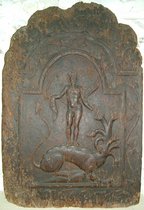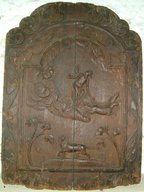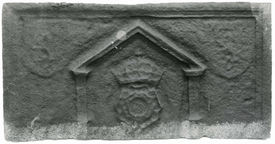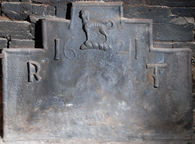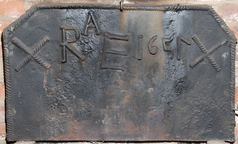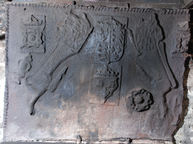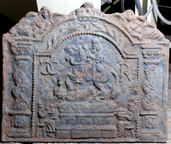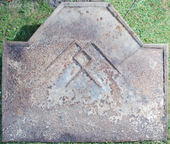-
927
Description: Carved wooden fireback pattern. Arched rectangular central panel, astragal and fillet edge, pictorial, Hercules, sword in hand, preparing to slay the Hydra; arched rectangular border, fillet edge, ivy leaves and tendrils, monogram at bottom; swirled foliage on top.
Notes: Unusually for a pattern, it was carved from a single piece of wood; formerly in the custody of William Hobday (d. 1883), last surviving ironworker at Ashburnham furnace, this pattern was given to the Sussex Archaeological Society by the Revd. J. Bickersteth.
Inscription: TAN
- Decoration tags:
- 'Dutch' (shape)
- fillet (edging)
- whole carved pattern
- pictorial
- mythological
- text
- animals
- humans
Manufactured: in the early-18th century in England.
Current location: Anne of Cleves House, Southover High Street, Lewes, East Sussex, England.
(part of the Sussex Archaeological Society museum group)
Citation: Dawson, C., 1903, 'Sussex Iron Work and Pottery', Sussex Archaeological Collections, 46, pp. 1-54.
- Attached to series:
- Patterns
- TAN series
-
928
Description: Carved wooden fireback pattern. Arched rectangular central panel with astragal and fillet edging; Phaëton riding Apollo’s chariot across the skies, the sun to the left behind clouds, a lion on ground below, between two trees; arched rectangular border with fillet edging; trailing convolvulus leaves surround the central panel.
Notes: The illustration upon which the design has been based has not been identified, save that it figures in book II of Ovid's Metamorphoses. The convolvulus border is a common feature of this series of firebacks; given to the Sussex Archaeological Society by the Rev. J. Bickersteth.
- Decoration tags:
- 'Dutch' (shape)
- fillet (edging)
- whole carved pattern
- planklines
- pictorial
- mythological
- animals
- humans
- objects
Manufactured: in the early-18th century in England.
Current location: Anne of Cleves House, Southover High Street, Lewes, East Sussex, England.
(part of the Sussex Archaeological Society museum group)
Citation: Baines, J. M., 1958, Wealden Firebacks (Hastings Museum).
Citation: Dawson, C., 1903, 'Sussex Iron Work and Pottery', Sussex Archaeological Collections, 46, pp. 1-54.
- Attached to series:
- Patterns
- TAN series
-
1053
Description: Rectangular; cyma curve and fillet edging; crowned Tudor rose within a pediment resting on Tuscan pilasters and pedestals; faint impression of a shield bearing a lion rampant repeated in each top corner.
Notes: The width of this fireback may indicate that another fireback in this series was used as its pattern and the shields added before casting.
- Decoration tags:
- rectangular (shape)
- cyma curve and fillet (edging)
- carved stamps
- whole carved pattern
- heraldic
- architectural
- armorial
- royal
Manufactured: in the mid- to late-16th century in the Weald area of England.
Current location: Anne of Cleves House, Southover High Street, Lewes, East Sussex, England.
Museum number: LH000.954 (part of the Sussex Archaeological Society museum group)
- Attached to series:
- Miscellaneous royal firebacks
- Pedimented rose and crown series
-
945
Description: Rectangular with two-stepped top; twisted rope edging (top and sides) formed of short rope sections, with top vertical sections extending down beyond the join with the next horizontal section; top centre, stamp formed of a talbot statant guardant upon a wreath; date separated by crest stamp; initials below and separated by date.
Notes: The talbot crest has been seen on other firebacks indicating a common source.
Inscription: 16 21 / R T
- Decoration tags:
- stepped (shape)
- rope (edging)
- simple stamps
- carved stamps
- individual letters
- individual numbers
- heraldic
- text
Manufactured: in 1621 in the Weald area of England.
Current location: in private hands, Lindfield, West Sussex, England.
- Attached to series:
- Talbot crest series
- Stepped firebacks
-
946
Description: Canted rectangle; twisted rope edging (top and sides); initials in triad to left of date (7 reversed), all between two twisted rope saltires.
Notes: The distinctive form of the number '5' has been seen on other firebacks indicating a common source.
Inscription: RAE [triad] 1657
- Decoration tags:
- rectangular with canted top corners (shape)
- rope (edging)
- simple stamps
- individual letters
- individual numbers
- apotropaic
- text
- objects
Manufactured: in 1657 in the Weald area of England.
Current location: in private hands, Lindfield, West Sussex, England.
- Attached to series:
- Rope design firebacks
- Shortened '5' series
-
463
Description: Fragment; rectangular; twisted rope edging (top and side); top centre, crowned Tudor royal shield (over-pressed) above a crowned shield (over-pressed) bearing initials above a fleur-de-lys; to left, a leopard passant guardant sinister diagonally position with its rear toward the bottom left corner; to right, a leopard passant, also diagonally positioned, its rear towards the bottom right; in the top corners, a crowned four-petalled rose (over-pressed); below the left rose, a left-directed ‘imp’ figure looking right, its arms lowered; bottom right, a left-directed ‘imp’ figure, its left arm raised; to right of the lower shield, a four-petalled rose askew.
Notes: One of the ‘Royal’ series.
Arms: Tudor royal arms of England
- Decoration tags:
- rectangular (shape)
- rope (edging)
- carved stamps
- heraldic
- armorial
- royal
- animals
- humans
Manufactured: in the mid-16th century in the Weald area of England.
Current location: in private hands, Little Horsted, East Sussex, England.
- Attached to series:
- Royal series
-
464
Description: Arched rectangular shaped central panel, bead edging (top and sides), pedestal bearing a supine male figure with headband being trampled by a horse, facing left, mounted by a rider with long hair, facing to the front; on each side of the plinth is a seated figure with a basket of fruit; the inscription is split either side of the horse; arched rectangular shaped border, fillet edging, on each side a Solomonic column with vine decoration; in the arch, symmetrical parallel curved lines intertwined beneath a crown; on top of each shoulder of the plate a female figure in repose.
Notes: The equestrian figure is derived from the statue of Charles II erected in Stocks Market, London, in 1672. Originally to be of Jan Sobieski, later king of Poland, riding down a Tatar, it was altered to represent Charles, and the Tatar’s face was changed to that of Oliver Cromwell; the statue attracted a fair degree of derision. The 'CC' monogram is likely to be for Charles and Catherine (of Braganza). The statue is now at Newby Hall, near Ripon, North Yorkshire. Another version (no. 280), probably by the same pattern-maker, is dated 1674 and has altered initials.
Copies of this fireback are known.
Inscription: CC [interlocked, and the first reversed] R
- Decoration tags:
- 'Dutch' (shape)
- ovolo (edging)
- whole carved pattern
- individual letters
- pictorial
- historical
- text
Manufactured: in the mid- to late-17th century in England.
Current location: in private hands, Little Horsted, East Sussex, England.
- Attached to series:
- Carolean 'Dutch' series
- Commemorative firebacks
-
465
Description: Rectangular with three-faced arch; ogee moulded edging; top centre, overlapping, crossed staples arranged diagonally, each pointing to a bottom corner.
Notes: The crossed staple is the badge of the Nevill family, and this fireback came from Eridge Park, the seat of the Marquess of Abergavenny.
- Decoration tags:
- rectangular with three-facetted arch (shape)
- cyma reversa/ogee (edging)
- simple stamps
- heraldic
- objects
Manufactured: in the 18th century possibly in the Weald area of England.
Current location: in private hands, Little Horsted, East Sussex, England.
- Attached to series:
- Personal firebacks
- Metalware stamp firebacks
-
1272
Description: Arched rectangular shape with side pilasters; cavetto-moulded edging to the arch; quartered shield with an, off-centre, knight's helm, wreath and mantling, and crest of a cubit arm vested, or habited, cuffed and erased holding an arrow in bend sinister; the shield has, in the 1st quarter three lions rampant, in the 2nd a bend cotised, in the 3rd possibly a lion rampant, and in the 4th possibly a dragon rampant within a bordure indented; motto below the shield.
Notes: From the style of the mantling the pattern carver may have also been responsible for other firebacks from the west Midlands or Welsh border area.
Copies of this fireback are known.
Inscription: SVCH CAVSE I FIND
Arms: Not known
- Decoration tags:
- rectangular with round arch (shape)
- cavetto (edging)
- whole carved pattern
- heraldic
- armorial
- text
Manufactured: in the early- to mid-17th century in England.
Current location: Littlehampton Museum, Manor Road, Littlehampton, West Sussex, England.
Museum number: A263 (part of the Littlehampton Museum museum group)
- Attached to series:
- Herefordshire armorial series
- Personal armorial firebacks
-
472
Description: Rectangular with central triangular arch; twisted rope edging (top and sides); in arch, on top, a small cross formed of fleurs-de-lys above a rose and crown with dragon and lion supporters above two crowned shields each bearing a small fleur-de-lys; text across top half, a small cross formed of fleurs-de-lys ending the first and third lines, the top two lines split by the crowned shields, each word separated by two opposed fleurs; below the text, four crowned shields each with a fleur-de-lys, the date between the middle two; lower left, 'I'; lower right, 'A'.
Notes: The inscription can be interpreted as Thomas Anstie alias Field and Denise his wife (etc.), the surname Anstie alias Field being known in the 16th century in central Sussex. A Thomas Anstye married Denys Joyner at Wivelsfield, Sussex on 5th June 1564; illustrated in Lower, 1849 p. 189 with some errors in transcription of the inscription; formerly at 'Misfield' (Miswell), Worth, Sussex. One of a small series of distinctive firebacks cast in 1582, most with inscriptions dedicated to pairs of individuals; the initials IA are likely to be of the founder as they appear in the same arrangement on the other firebacks; the rose and crown and supporters stamp can also be seen on a large fireback, dated 1593, formerly at Baynard's Park, Surrey (no. 200).
Inscription: THOMAS VNSTE / ALIS : FILD AND DINIS / HIS : WIF: ANO : DOMINO: / 1582 / I A
- Decoration tags:
- rectangular with triangular arch (shape)
- rope (edging)
- carved stamps
- individual letters
- individual numbers
- heraldic
- text
Manufactured: in 1582 possibly at Pounsley Furnace, Framfield in the Weald area of England.
Current location: Gwesty Seren Hotel (formerly Bryn Llewellyn), Allt Goch, Llan Ffestiniog, Gwynedd, Wales.
- Attached to series:
- Pounsley series
- 1582 IA series
